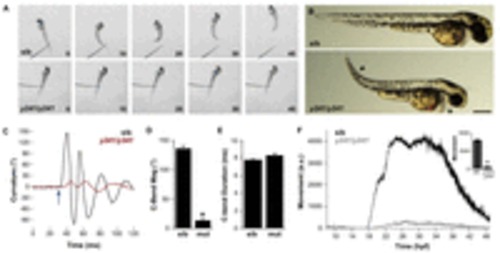Fig. 1
|
Embryonic motility is impaired in y241 mutant embryos. (A) Swimming response to a tactile stimulus is severely impaired in 2 dpf y241 mutants. Image frames are at 10 ms intervals from a touch stimulus delivered with a fine needle. Siblings (top panels) swim rapidly forward, whereas mutants (lower panels) respond with a barely perceptible shiver. (B) y241 mutants (bottom panel) show edema adjacent to the heart (asterisk), tail curvature (arrowhead) and smaller eyes. Scale bar: 300 μm. (C) Curvature trace for 120 ms during an acoustic startle response in a sibling (black) and y241 mutant (red) embryo. The stimulus was delivered at 30 ms (arrow). (D) The magnitude of the initial C-bend in y241 mutant acoustic startle responses is reduced compared with that of wild-type embryos (n=6 larvae each), whereas (E) the duration of the initial C-bend is not significantly different. *P<0.001. (F) Spontaneous coiling is strongly reduced in y241 mutants (gray, n=7) compared with wild-type siblings (black, n=37) during the entire period of early locomotor development. y-axis is arbitrary units. Inset, average coiling during 24–28 hpf for the same larvae. *P<0.001. Graphs show mean ± s.e.m. |
| Fish: | |
|---|---|
| Observed In: | |
| Stage: | Long-pec |

